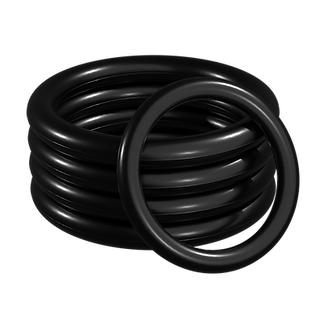Nuclear Safe EN 14582 O-rings & Gaskets
Updated: Jul 26, 2024
Nuclear power plants rely on a range of mechanical systems to ensure safe and efficient operations. These systems often operate at high temperatures and pressures, which can cause standard O-rings to fail. To ensure reliable sealing, nuclear power plants use specialized Nuclear Safe EN 14582 O-rings, rubber, and gaskets. In this blog, we will explore the importance of Nuclear Safe EN 14582 O-rings and their impact on the nuclear industry.
What are Nuclear Safe EN 14582 O-rings?

Nuclear Safe EN 14582 O-rings are specialized seals designed for use in nuclear power plants. These O-rings are made from high-quality materials that are resistant to radiation, heat, and pressure. They are tested to withstand a range of conditions and meet strict safety standards set by the nuclear industry.
Why are Nuclear Safe EN 14582 O-rings important?
Nuclear Safe EN 14582 O-rings are important because they ensure the safe and reliable operation of mechanical systems in nuclear power plants. The seals used in these systems are critical to preventing leaks and maintaining a safe working environment. If these seals fail, it can result in equipment failure, leaks, and potentially dangerous situations for personnel.
Nuclear Safe EN 14582 O-rings are designed to withstand high temperatures and pressures and resist degradation from radiation exposure. This makes them a reliable choice for use in nuclear power plants, where safety and reliability are of utmost importance.
EPDM is frequently used in nuclear applications because of its excellent resistance to radiation and its ability to withstand high temperatures. In nuclear power plants, EPDM is commonly used for sealing applications, such as sealing doors and penetrations. It is also used in the construction of containment vessels and for sealing around piping and equipment.
EPDM is an ideal material for nuclear applications because it is able to maintain its properties even when exposed to high levels of radiation. With the right formulation, it does not degrade or break down, which is important for ensuring the safety and integrity of the nuclear facility. Additionally, EPDM is resistant to chemicals that are commonly found in nuclear environments, which makes it a reliable material for use in nuclear facilities.
When considering EPDM rubber for use in nuclear power energy applications, one important characteristic to consider is its "low extractables" property. Low extractables refer to the minimal amount of substances that can be released or leached out from the rubber material.
In nuclear power applications, it is crucial to minimize the introduction of foreign substances or contaminants that could potentially interact with the nuclear materials or compromise the integrity of the system. EPDM rubber with low extractables helps reduce the risk of introducing unwanted chemicals or impurities into the nuclear environment.
To ensure low extractables in EPDM rubber, manufacturers typically employ specific manufacturing processes and formulations. These processes aim to minimize the presence of volatile or leachable compounds within the rubber material. The rubber can undergo treatments or purification steps to remove any impurities, ensuring its suitability for nuclear applications.
When selecting EPDM rubber for use in nuclear power energy, it is essential to work closely with rubber manufacturers or suppliers who specialize in producing materials for nuclear applications. They can provide EPDM formulations that have been specifically developed and tested to meet the stringent requirements and regulations of the nuclear industry.
Introducing Canyon EP75BK28 EPDM specially formulated with low extractables for use in Nuclear power generation applications. Canyon EP75BK28 has been tested per EN 14582 & IC and US EPA 3052 & EA & ICP-OES to measure harmful element content to ensure minimal extractables. If you’re interested in learning more about EP75BK28, see the EP75BK28 datasheet.
If you want to learn more about EPDM, see our EPDM page, or see the EPDM blog post.
Impact on the Nuclear Industry
The use of Nuclear Safe EN 14582 O-rings has had a significant impact on the nuclear industry. These specialized seals ensure the safe and reliable operation of mechanical systems in nuclear power plants, reducing the risk of equipment failure and leaks. The use of these O-rings has also resulted in increased efficiency and reduced downtime, which translates to cost savings for the nuclear industry.
In addition to their use in nuclear power plants, Nuclear Safe EN 14582 O-rings are also used in other applications where radiation exposure is a concern, such as in medical and scientific research facilities.
Conclusion
In conclusion, Nuclear Safe EN 14582 O-rings are critical components in the safe and reliable operation of mechanical systems in nuclear power plants. These specialized seals are designed to withstand high temperatures, pressures, and radiation exposure, ensuring the safety of personnel and preventing equipment failure and leaks. The use of Nuclear Safe EN 14582 O-rings has had a significant impact on the nuclear industry, increasing safety, efficiency, and cost savings. Their use in other industries with radiation exposure concerns further highlights the importance and versatility of these specialized O-rings.
Where can I get Nuclear Safe parts?
With the request a quote page, you can get directly in contact with our team of specialists who will help get you the parts you need.


